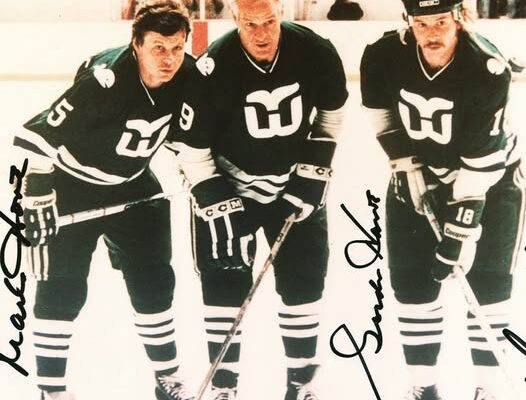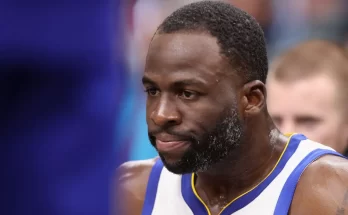Gordie Howe and the Howe Legacy: A Unique Season with the Hartford Whalers
When discussing hockey legends, few names resonate as profoundly as Gordie Howe’s. Known affectionately as “Mr. Hockey,” Gordie’s impact on the game transcends statistics and records; he embodied the grit, skill, and heart that define the sport. His journey from a small town in Saskatchewan to becoming an NHL icon is one filled with tales of toughness, endurance, and family devotion. Yet, among the many remarkable stories of his career, one season stands out as uniquely special: the year Gordie played alongside his sons Mark and Marty Howe with the Hartford Whalers.
Gordie Howe’s hockey career began in the 1940s and spanned over five decades—a feat almost unheard of in professional sports. His NHL career with the Detroit Red Wings, where he earned the nickname “Mr. Hockey,” lasted from 1946 until 1971, during which he won four Stanley Cups and six Hart Trophies as league MVP. Howe was the embodiment of the power forward: a player who combined size, skill, and toughness in a way that few others ever have.
But Gordie’s story doesn’t end with the NHL. In the 1970s, he joined the World Hockey Association (WHA), a rival league to the NHL, playing for the Houston Aeros and later the New England Whalers. It was during this era that an unprecedented chapter unfolded—Gordie was joined on the ice by his two sons, Mark and Marty Howe. This father-son trio was a rare phenomenon in professional sports and highlighted not only the longevity of Gordie’s career but also the hockey pedigree that ran in the family.
After the WHA merged with the NHL in 1979, the New England Whalers became the Hartford Whalers. Gordie Howe, then in his early 50s, returned to the NHL alongside his sons Mark and Marty for the 1979-1980 season. This season was historic: Gordie Howe, at 51 years old, became the oldest player in NHL history to play, while sharing the ice with his two sons—a first in league history.
Mark Howe, a talented defenseman, had already established himself as a skilled and intelligent player known for his smooth skating and sharp hockey sense. Marty Howe, a rugged defenseman like his father, brought toughness and reliability to the blue line. Together, the Howes represented three generations of hockey excellence in one family.
Their presence on the Hartford Whalers was more than just a novelty—it was a testament to the enduring passion for the game that Gordie instilled in his children. Gordie’s ability to compete at the highest level with players half his age was remarkable and inspirational, earning admiration from teammates, fans, and opponents alike.
To understand the significance of that season, one must appreciate the man behind the name. Gordie Howe was famous for his physical style of play, his uncanny scoring ability, and his legendary toughness. He was known for his “Gordie Howe Hat Trick”: a goal, an assist, and a fight all in one game—a rare combination that perfectly symbolized his multifaceted game.
Stories about Gordie Howe abound among hockey circles. One tale recalls his relentless durability; over his 26 seasons with the Detroit Red Wings, he rarely missed a game. He was said to have played through injuries that would sideline many players today. His training regimen was simple but effective: skate hard, play hard, and never give up. Howe’s dedication to fitness and preparation allowed him to play well into his 50s, an unheard-of accomplishment at the time.
Off the ice, Gordie was a family man and a humble competitor. He stayed away from the celebrity spotlight, focusing instead on mentoring younger players and enjoying his family life. The fact that he played with Mark and Marty was as much a personal achievement as a professional one. Imagine the pride in Gordie’s heart skating alongside his sons, passing down the lessons he learned over a lifetime.
The Hartford Whalers were not a powerhouse team in the NHL, but their 1979-1980 season will forever be remembered for the unique composition of the Howe family on the roster. Gordie, Mark, and Marty often shared ice time, creating opportunities for fans to witness hockey history firsthand.
That season was also a testament to the evolution of hockey. The NHL had grown faster and more physical over the years, yet Gordie’s skill and hockey intelligence kept him competitive. Mark and Marty, each with their distinct styles, represented the new generation of players—faster, more specialized, and equally tough.
While Gordie’s scoring numbers had slowed compared to his prime, his influence extended beyond points. He was a leader and an example, showing that age could not diminish passion or commitment. His presence inspired teammates and drew crowds eager to see the legend in action.
Mark Howe would go on to have a Hall of Fame career, known for his two-way excellence and leadership. Marty also carved out a respectable career, underscoring that the Howe family legacy was far from a one-man show.
Gordie Howe’s story inevitably leads to discussions about the greatest players to ever lace up skates. Hockey has seen many legends, each bringing their own unique contributions to the game.
- Wayne Gretzky, “The Great One,” is often cited as the best player ever, holding records for most goals, assists, and points. Gretzky’s vision, anticipation, and creativity on ice changed the way hockey was played and appreciated.
- Bobby Orr revolutionized the defenseman position with his offensive skills and skating ability. Orr was the first defenseman to dominate scoring, redefining the role and influencing generations of players.
- Mario Lemieux, known for his combination of size, skill, and finesse, overcame numerous injuries and health challenges to remain one of the most dominant players in NHL history.
- Other legends like Maurice “Rocket” Richard, Jean Béliveau, and Doug Harvey contributed to the game’s rich history, each representing different eras and styles.
What sets Gordie Howe apart, though, is his all-around game and unparalleled longevity. He was not only an elite scorer but also a fierce competitor and a player who embodied the physical, gritty style of hockey that defined his era. The fact that he successfully transitioned through multiple generations of hockey styles—from the Original Six NHL days to the more modern game of the late 1970s—speaks volumes about his adaptability and love for the sport.
The Howe family’s impact on hockey goes beyond statistics and trophies. Gordie’s example inspired countless young players, especially those from small towns in Canada and the United States, proving that with hard work and determination, you could reach the highest levels of the game.
Mark Howe’s career also extended into coaching and broadcasting, continuing to shape the game after his playing days. Marty contributed to the sport in various roles, including coaching and youth development, ensuring the family legacy would influence future generations.
Gordie Howe’s influence is celebrated through numerous honors and awards, including the annual Gordie Howe Trophy, given to the NHL’s most outstanding player. His number 9 jersey is retired by the Detroit Red Wings, and his name is synonymous with hockey excellence.
The 1979-1980 Hartford Whalers season, featuring Gordie Howe playing alongside Mark and Marty Howe, remains one of the most unique chapters in NHL history. It was a living testament to family, endurance, and the love of hockey. Watching a father skate shoulder-to-shoulder with his sons in the world’s toughest hockey league was more than a sports story—it was a human story, one of legacy, perseverance, and passion.
Gordie Howe’s career and the remarkable season with his sons remind us that hockey is more than a game. It is a tradition passed down through generations, a sport that connects families, communities, and fans. And while the best players to ever play the game each have their own place in history, Gordie Howe’s story remains a shining example of the timeless spirit of hockey.



